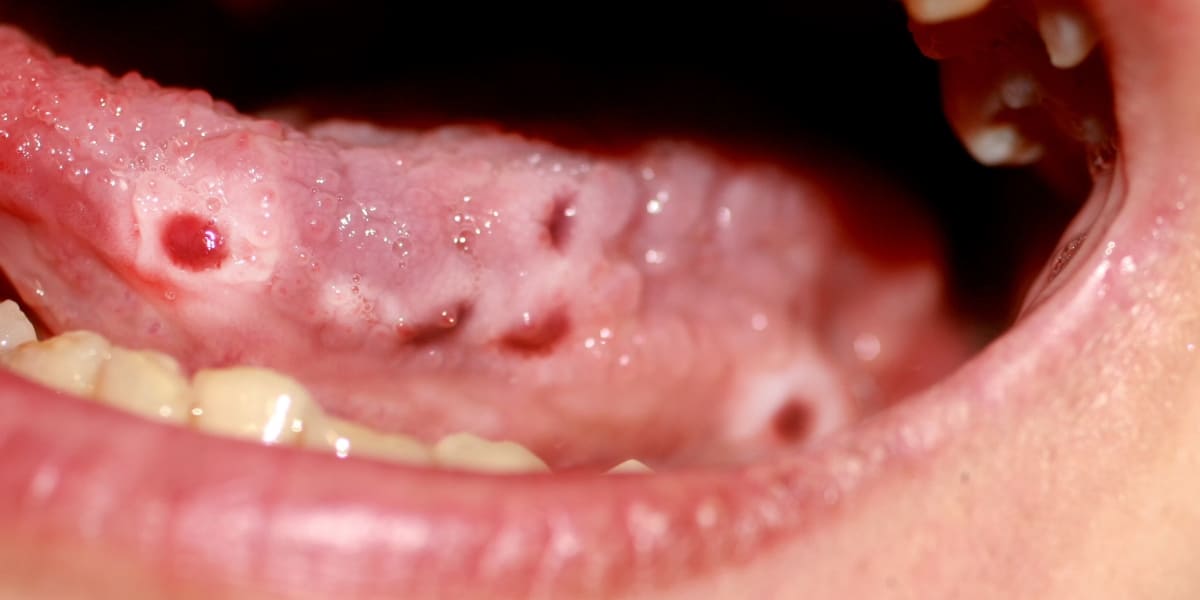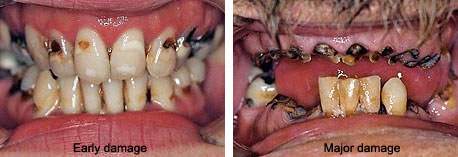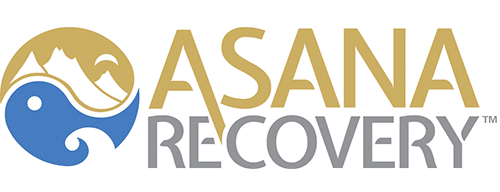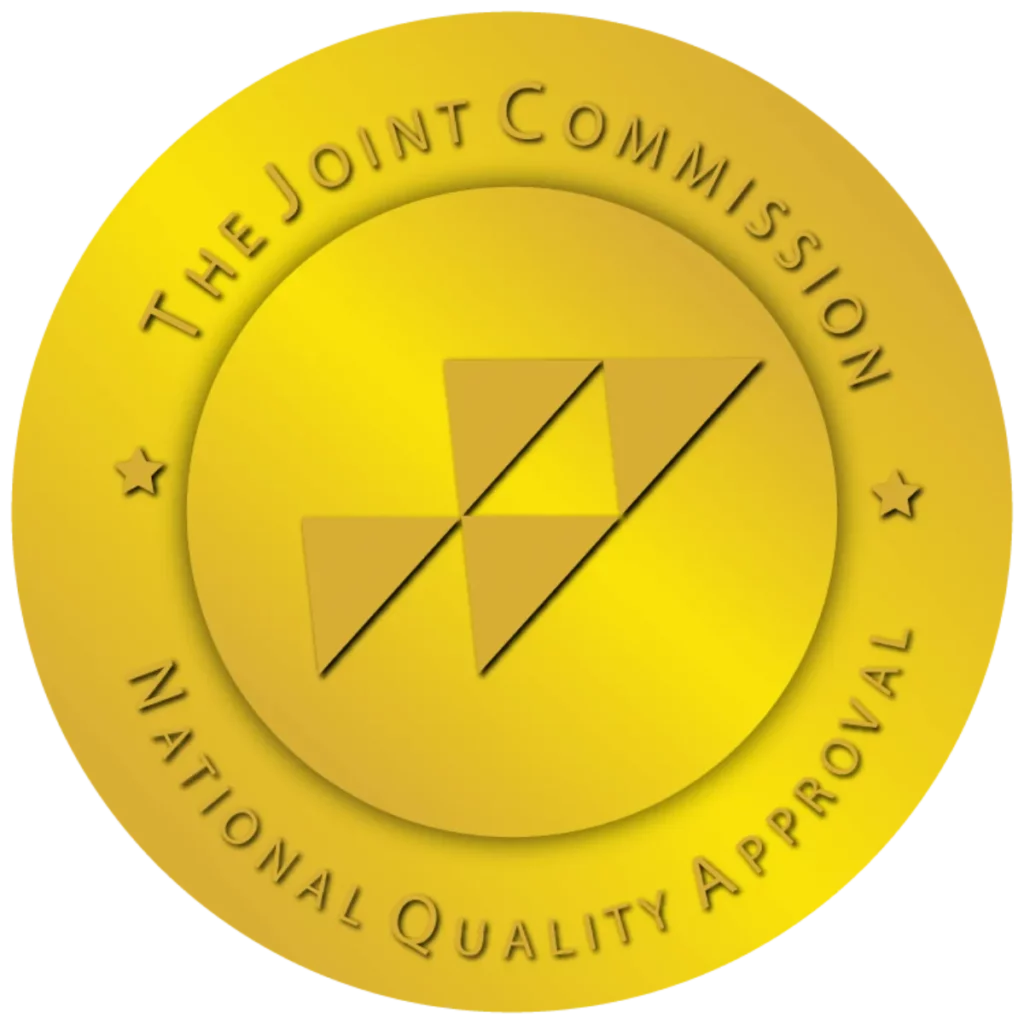Among people aged 12 or older in 2021, an estimated 0.6% (or about 1.6 million people) had a methamphetamine use disorder in the past 12 months (2021 DT 5.1) [1] “Meth Mouth” is a type of dental condition that is common among methamphetamine (“Meth”) users—a very potent and highly addictive stimulant. This dental condition is related to severe decay and damage to the teeth and it becomes a matter of time for the users to lose their oral health.
Street names for methamphetamine include Crank, Crypto, Fire, Meth, and Speed. Methamphetamine can be smoked, snorted, injected, or taken orally. Typically, it is a bitter-tasting powder that readily dissolves in water or alcohol. To be smoked, methamphetamine powder needs to be purified into a large crystal. Hence the names: Crystal Meth, Crystal Glass, and Ice.
Statistical Overview of Meth Mouth Prevalence and Impact
The prevalence and impact of “Meth Mouth” are significant, reflecting the broader public health challenge posed by methamphetamine abuse.
Prevalence Rates
One study indicated a high prevalence (43.3%) of “Meth Mouth” among methamphetamine users, with rates varying depending on the population studied and the criteria used for diagnosis. Contrary to common perception, users who smoke or inhale MA have lower rates of dental disease than those who inject the drug [2].
According to the American Dental Association, a significant proportion of individuals who use methamphetamine exhibit symptoms of “Meth Mouth [3]“, though specific percentages may vary. Some research suggests that over 60% of methamphetamine users have poor oral health such as missing teeth, with many displaying advanced tooth decay and gum disease that are characteristic of “Meth Mouth.”
Correlation Between Meth Use and Oral Health Deterioration
The oral effects of methamphetamine use can be one of the most visible and devastating consequences of its use. The correlation between methamphetamine use and the deterioration of oral health is well-documented. Methamphetamine’s acidic nature, combined with its effects on saliva production and the user’s neglect of oral hygiene, contribute directly to the condition. Studies have shown that the onset of “Meth Mouth” symptoms can occur within a year of regular meth use, with the severity of dental issues correlating with the frequency and duration of drug use.
Statistical data highlight the direct impact of methamphetamine on oral health. For instance, users are significantly more likely to have cavities, missing teeth, and gum disease compared to the general population. The average number of missing teeth among meth users is often several times higher than that of non-users.
The impact of “Meth Mouth” extends beyond oral health, affecting individuals’ nutritional intake, self-esteem, and overall quality of life. The treatment of “Meth Mouth” is challenging and costly, often requiring extensive dental procedures, which underscores the importance of preventive measures and early intervention in addressing methamphetamine abuse.
Causes of Meth Mouth
Methamphetamine use decreases the amounts of saliva produced. Saliva is needed to neutralize acids produced by bacteria in the mouth, to wash away food particles from the teeth, and to keep the mouth moist. A dry mouth becomes a source of infections and tooth decay.
Meth is also highly acidic, and this is compounded by users’ poor oral habits such as improper brushing and flossing. Compulsive teeth grinding and craving for sugary drinks are also quite common among Meth users, speeding up the process of formation of “Meth Mouth” from rapid onset to rapid progression.




Symptoms of Meth Mouth
Meth use not only aesthetically disfigures the person but ultimately leads to serious health complications, particularly:
- Cavities
- Black teeth
- Infections
- Chronic pain
- Tooth decay starting at the gum line
- Gum disease (gingivitis/periodontitis
- Loss of teeth
- Decay on the cheek side smooth surface of the teeth and between the front teeth
- Lockjaw
- Lack of pain
Teeth are described as “blackened, stained, rotting, crumbling or falling apart” [2].
Treatment Options for Meth Mouth
Treating “Meth Mouth” involves both immediate dental interventions and a long-term approach that includes addiction treatment. The goal is to address acute dental issues and facilitate the patient’s recovery from substance abuse, recognizing the intertwined nature of dental health and addiction.
Immediate Dental Interventions
Immediate dental treatments for Meth Mouth focus on managing pain, infection, and preventing further decay or damage. Dentists may initially prescribe antibiotics to tackle infections and recommend professional cleaning to mitigate decay. In cases of severe decay, tooth extractions may be necessary. For teeth that can be saved, restorative treatments such as fillings, crowns, and root canals are employed to restore functionality and aesthetics. These interventions aim to stop the progression of damage and alleviate immediate discomfort.
Additionally, fluoride treatments often strengthen the remaining tooth structure and combat further decay. Dentists may also provide specialized mouthwashes to enhance oral hygiene and combat dry mouth, a common issue in meth users that exacerbates dental problems.
Long-term Recovery and Care
The long-term management of Meth Mouth extends beyond dental treatments to address the root cause of the condition: methamphetamine addiction. Integrating addiction treatment programs is crucial for preventing relapse into drug use and ensuring the durability of dental interventions. Comprehensive addiction treatment often includes counseling, behavioral therapies, and support groups, providing individuals with the tools to overcome their dependency.
Moreover, educating patients on the importance of oral hygiene and regular dental checkups is a critical component of long-term care. Patients learn to adopt healthier lifestyles and oral hygiene practices, significantly reducing the risk of future dental issues. Dentists may work closely with addiction specialists to tailor a holistic recovery plan that addresses both dental health and substance abuse, recognizing the importance of treating the individual as a whole.
In summary, treating Meth Mouth requires a multifaceted approach that combines immediate dental care with long-term addiction treatment and education. This comprehensive strategy not only aims to repair the physical damage caused by methamphetamine use but also supports the individual’s journey toward recovery and a healthier future.
Prevention and Public Health Implications
Preventing “Meth Mouth” requires a multifaceted public health approach that includes education, early intervention, and support for recovery and rehabilitation. The overarching goal is to reduce methamphetamine use and its devastating impact on dental health through comprehensive strategies targeting at-risk populations and supporting individuals in their recovery journey.
Educating At-Risk Populations
Education plays a pivotal role in preventing Meth Mouth by informing potential and current meth users about the risks associated with the drug, including its harmful effects on oral health. Public health campaigns and educational programs designed to reach at-risk populations can utilize various platforms, such as social media, community centers, schools, and healthcare settings, to disseminate information about the causes and consequences of Meth Mouth.
These initiatives can include detailed descriptions of Meth Mouth symptoms, the relationship between meth use and oral health deterioration, and personal stories to illustrate the real-world impact of the condition. By raising awareness, these educational efforts aim to deter individuals from starting or continuing meth use.
Incorporating oral health education into broader drug prevention programs can also emphasize the connection between substance abuse and dental health, encouraging preventive behaviors and early treatment seeking. Engaging dental professionals in public health efforts allows for early detection and intervention, potentially preventing the progression of Meth Mouth in individuals who use meth.
Supporting Recovery and Rehabilitation
Rehabilitation programs play a crucial role in preventing Meth Mouth by addressing the root cause: methamphetamine addiction. Comprehensive rehabilitation services that include medical treatment, counseling, and support groups can help individuals overcome addiction, thereby indirectly preventing the onset or worsening of Meth Mouth. Programs like our residential treatment in California focus on recovery and relapse prevention, offering a path away from substance abuse and its associated health issues.
Furthermore, integrating dental care into addiction recovery programs ensures that individuals receive holistic treatment addressing both their addiction and its physical consequences. This integrated approach not only aids in the recovery process but also emphasizes the importance of oral health as part of overall well-being.
Supportive services, including access to dental care and education on maintaining oral hygiene, can significantly contribute to the long-term success of individuals in recovery, reducing the likelihood of relapse and the recurrence of Meth Mouth.
Preventing Meth Mouth and its public health implications requires a comprehensive strategy. These efforts collectively aim to reduce methamphetamine use and its harmful impact on individuals and communities.

Personal Stories and Recovery Journeys
The devastating effects of “Meth Mouth” on individuals’ lives are profound, yet stories of recovery offer hope and underscore the resilience of the human spirit. Here are four anonymized personal stories that illustrate the harsh realities of Meth Mouth and the transformative journeys toward recovery.
Story 1: Joe’s Wake-Up Call
Joe, a former construction worker, started using methamphetamine during long shifts to stay awake. Over time, his casual use spiraled into addiction. Within a year, John noticed his teeth deteriorating rapidly, suffering from severe decay and gum disease characteristic of Meth Mouth. The condition became a wake-up call, leading him to seek help. Through a combination of dental treatments to address the immediate damage and comprehensive addiction therapy, John has been sober for three years. He considers his restored smile a symbol of his recovery and a daily reminder of the life he left behind.
Story 2: Chloe’s Path to Self-Acceptance
Chloe was introduced to meth in her late teens. As her addiction took hold, so did the effects of Meth Mouth, leaving her with extensive dental damage and a shattered self-esteem. The turning point came when she joined a recovery program that offered not only addiction support but also access to dental care. Chloe’s journey was not just about overcoming addiction but also rebuilding her life and self-image. Today, she mentors young people struggling with substance abuse, sharing her story to inspire others.
Story 3: Alex’s New Beginning
Alex, a talented artist, saw his career and personal life decline due to meth use. His Meth Mouth symptoms were severe, leading to tooth loss and affecting his ability to speak and eat. The physical toll was matched by emotional distress. Seeking change, Alex entered a rehabilitation program, where he received the dental care needed to address his oral health issues. This care was pivotal in Alex’s recovery, helping him regain his health, confidence, and passion for art.
Story 4: Ella’s Road to Reconciliation
Ella’s addiction estranged her from her family. Her Meth Mouth condition was a visible sign of her struggle with methamphetamine, leading to embarrassment and isolation. However, Ella’s desire to reconnect with her loved ones motivated her to pursue recovery. Through a comprehensive treatment program that addressed both her addiction and dental health, Ella made significant strides. Her journey of healing allowed her to mend relationships and educate others about the dangers of meth use and the importance of oral health.
These stories highlight the severe impact of Meth Mouth but also emphasize the possibility of recovery and renewal. Through a combination of dental care, addiction treatment, and personal determination, individuals can overcome the challenges posed by Meth Mouth, reclaiming their health and futures.
Key Takeaways
- Meth Mouth” is a type of dental condition that is common among methamphetamine (“Meth”) users
- This dental condition is related to severe decay and damage to the teeth and it becomes a matter of time for the users to lose their oral health.
- There is a high prevalence of “Meth Mouth” among methamphetamine users, with rates varying depending on the population studied and the criteria used
- Some research suggests that over 60% of methamphetamine users have poor oral health
- The correlation between methamphetamine use and the deterioration of oral health is well-documented.
- The impact of “Meth Mouth” extends beyond oral health, affecting individuals’ nutritional intake, self-esteem, and overall quality of life.
- Methamphetamine use decreases the amounts of saliva produced which contributes to bacterial growth, combined witty the acidic nature of meth
- There are many symptoms of Meth Mouth; in general, teeth are described as “blackened, stained, rotting, crumbling or falling apart”.
- Treating “Meth Mouth” involves both immediate dental interventions and a long-term approach that includes addiction treatment.
- Preventing “Meth Mouth” requires a multifaceted public health approach that includes education, early intervention, and support for recovery and rehabilitation.
- While Meth Mouth is a severe and often shocking consequence of meth use, comprehensive treatment addressing both addiction and dental care can lead to recovery and improved oral health.
Sources
[1] National Institute on Drug Abuse. Methamphetamine Research Report. What is the scope of methamphetamine use in the United States?
[2] Shetty V, et al. 2010. The relationship between methamphetamine use and increased dental disease. J Am Dent Assoc. 2010;141:307–318.
[3] American Dental Association. 2023. Methamphetamine.





